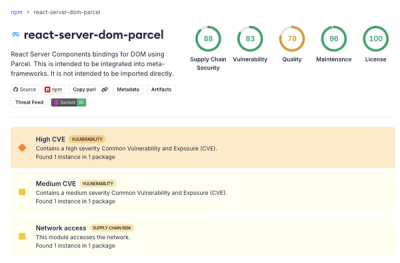
Security News
New React Server Components Vulnerabilities: DoS and Source Code Exposure
New DoS and source code exposure bugs in React Server Components and Next.js: what’s affected and how to update safely.

Draft.js is a JavaScript rich text editor framework, built for React and backed by an immutable model.
Learn how to use Draft.js in your own project.
Before getting started, please be aware that we recently changed the API of
Entity storage in Draft. The latest version, v0.10.0, supports both the old
and new API. Following that up will be v0.11.0 which will remove the old API.
If you are interested in helping out, or tracking the progress, please follow
issue 839.
npm install --save draft-js react react-dom
or
yarn add draft-js react react-dom
Draft.js depends on React and React DOM which must also be installed.
import React from 'react';
import ReactDOM from 'react-dom';
import {Editor, EditorState} from 'draft-js';
class MyEditor extends React.Component {
constructor(props) {
super(props);
this.state = {editorState: EditorState.createEmpty()};
this.onChange = (editorState) => this.setState({editorState});
this.setEditor = (editor) => {
this.editor = editor;
};
this.focusEditor = () => {
if (this.editor) {
this.editor.focus();
}
};
}
componentDidMount() {
this.focusEditor();
}
render() {
return (
<div style={styles.editor} onClick={this.focusEditor}>
<Editor
ref={this.setEditor}
editorState={this.state.editorState}
onChange={this.onChange}
/>
</div>
);
}
}
const styles = {
editor: {
border: '1px solid gray',
minHeight: '6em'
}
};
ReactDOM.render(
<MyEditor />,
document.getElementById('container')
);
Since the release of React 16.8, you can use Hooks as a way to work with EditorState without using a class.
import React from 'react';
import ReactDOM from 'react-dom';
import {Editor, EditorState} from 'draft-js';
function MyEditor() {
const [editorState, setEditorState] = React.useState(
EditorState.createEmpty()
);
const editor = React.useRef(null);
function focusEditor() {
editor.current.focus();
}
React.useEffect(() => {
focusEditor()
}, []);
return (
<div onClick={focusEditor}>
<Editor
ref={editor}
editorState={editorState}
onChange={editorState => setEditorState(editorState)}
/>
</div>
);
}
Note that the editor itself is only as tall as its contents. In order to give users a visual cue, we recommend setting a border and a minimum height via the .DraftEditor-root CSS selector, or using a wrapper div like in the above example.
Because Draft.js supports unicode, you must have the following meta tag in the <head> </head> block of your HTML file:
<meta charset="utf-8" />
Further examples of how Draft.js can be used are provided below.
Visit http://draftjs.org/ to try out a basic rich editor example.
The repository includes a variety of different editor examples to demonstrate some of the features offered by the framework.
To run the examples, first build Draft.js locally. The Draft.js build is tested with Yarn v1 only. If you're using any other package manager and something doesn't work, try using yarn v1:
git clone https://github.com/facebook/draft-js.git
cd draft-js
yarn install
yarn run build
then open the example HTML files in your browser.
Draft.js is used in production on Facebook, including status and comment inputs, Notes, and messenger.com.
 IE / Edge |  Firefox |  Chrome |  Safari |  iOS Safari |  Chrome for Android |
|---|---|---|---|---|---|
| IE11, Edge [1, 2] | last 2 versions | last 2 versions | last 2 versions | not fully supported [3] | not fully supported [3] |
[1] May need a shim or a polyfill for some syntax used in Draft.js (docs).
[2] IME inputs have known issues in these browsers, especially Korean (docs).
[3] There are known issues with mobile browsers, especially on Android (docs).
Check out this curated list of articles and open-sourced projects/utilities: Awesome Draft-JS.
Join our Slack team!
We actively welcome pull requests. Learn how to contribute.
Draft.js is MIT licensed.
Examples provided in this repository and in the documentation are separately licensed.
Slate is a completely customizable framework for building rich text editors. Unlike Draft.js, which provides a more opinionated structure, Slate offers more flexibility and control over the editor's behavior and appearance. It uses a more modern approach with a focus on immutability and functional programming.
Quill is a powerful, rich text editor that provides a wide range of features out of the box. It is more feature-rich and easier to set up compared to Draft.js, but it offers less flexibility for customization and control over the editor's internals.
ProseMirror is a toolkit for building rich text editors with a focus on extensibility and customizability. It provides a more modular approach compared to Draft.js, allowing developers to build complex editors with custom behaviors and features.
FAQs
A React framework for building text editors.
The npm package draft-js receives a total of 724,697 weekly downloads. As such, draft-js popularity was classified as popular.
We found that draft-js demonstrated a not healthy version release cadence and project activity because the last version was released a year ago. It has 5 open source maintainers collaborating on the project.
Did you know?

Socket for GitHub automatically highlights issues in each pull request and monitors the health of all your open source dependencies. Discover the contents of your packages and block harmful activity before you install or update your dependencies.

Security News
New DoS and source code exposure bugs in React Server Components and Next.js: what’s affected and how to update safely.

Security News
Socket CEO Feross Aboukhadijeh joins Software Engineering Daily to discuss modern software supply chain attacks and rising AI-driven security risks.

Security News
GitHub has revoked npm classic tokens for publishing; maintainers must migrate, but OpenJS warns OIDC trusted publishing still has risky gaps for critical projects.